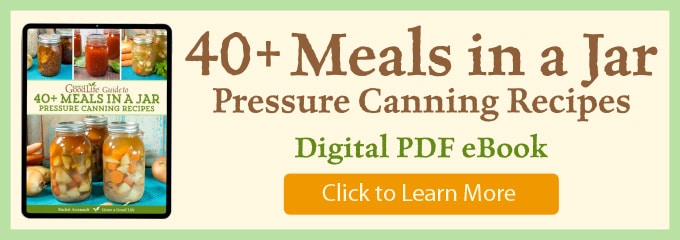Safe Substitutions for Home Canning Recipes
This post may contain affiliate links, which means that I may receive a commission if you make a purchase using these links. As an Amazon Associate I earn from qualifying purchases.
Learn which ingredient changes are safe for home canning. This guide covers approved swaps for tomatoes, salsa, pickles, vegetables, meats, fruits, soups, and meals in a jar, allowing you to adjust flavors while ensuring your preserves are safe and shelf-stable.
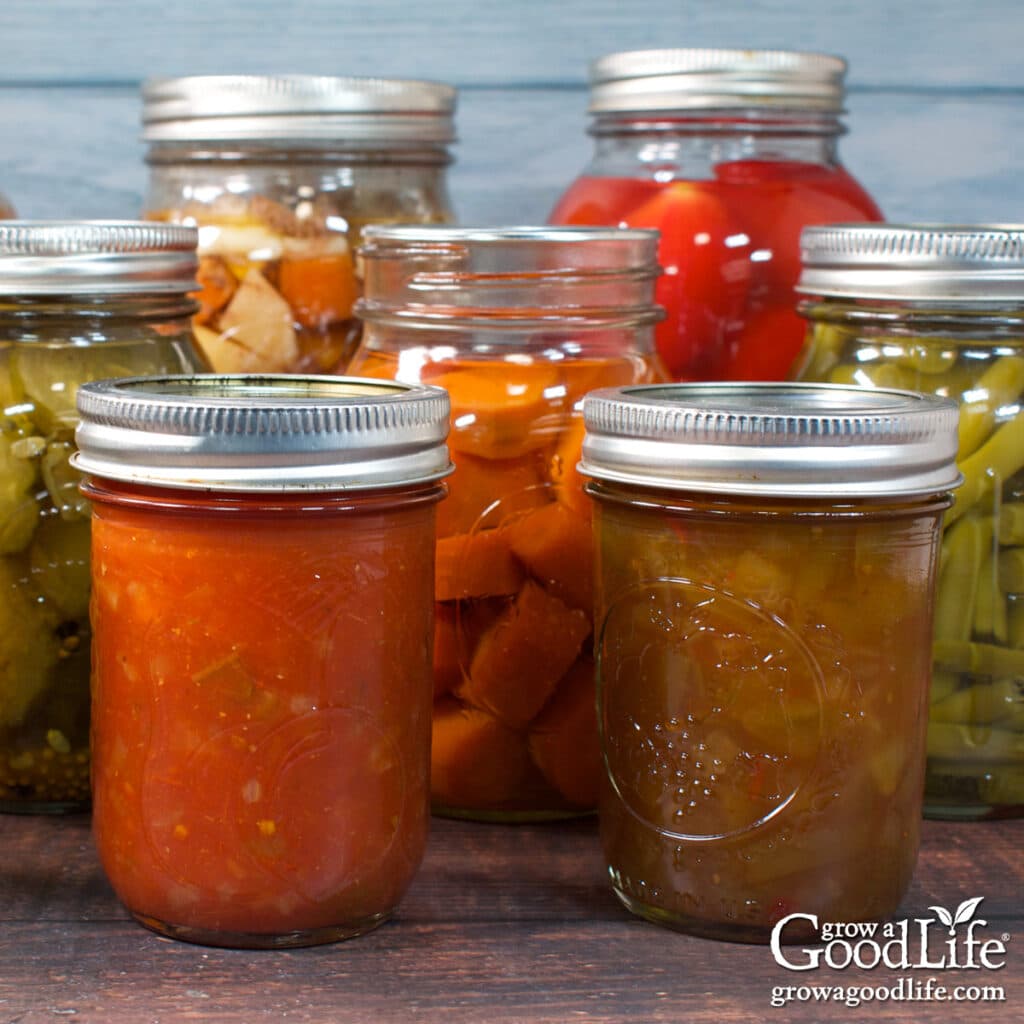
If you’ve ever wondered if it is ok to tweak a home canning recipe, maybe to cut down on sugar, swap in a favorite herb, or use what you have in the pantry, you’re not alone. One of the most common questions I receive when I share a canning recipe is, “Can I change this?” It’s a great question, and the answer depends on the recipe and the change you want to make.
Unlike cooking, where you can toss in a little of this or that, canning recipes are carefully developed to ensure food safety. They’re tested not just for flavor and texture, but also for pH, density, and how heat moves through the jar during processing. Even small changes can affect whether a canned product is safe for long-term shelf storage.
In this article and throughout our Safe Canning Substitutions Series, you’ll learn which changes are approved, which ones are risky, and how to safely adapt your favorite canning recipes.
How I Adapt and Share Safe Canning Recipes
When I publish a recipe adapted from safe canning resources, it’s not something I throw together in an afternoon. It usually takes many rounds of evaluation, and sometimes years, before I feel it’s ready to share.
- Start with the Original Tested Recipe: I always start by following the original tested recipe exactly as written. Not only are lab tested recipes tested for safety, but they also analyze the quality of the preserved food, such as flavor, color, and texture. So following the tested safe canning recipe as written gives me the foundation, a good place to start.
- Initial Storage and Flavor Evaluation: I store the jars for 3 to 6 months after canning. This waiting period allows the flavors to develop. The ingredients mingle, acids mellow, seasonings deepen, and the overall profile evolves.
- Begin Safe Tweaks, One Batch at a Time: After tasting, I begin experimenting with small, safe changes to enhance or personalize the flavor. Each batch is carefully documented and taste-tested after storage. Then the process is repeated and refined as many times as needed. I take detailed notes after each round to track what works and what doesn’t.
- Final Testing and Documentation: Once I’m confident in the recipe, I do another round (or two) to photograph the process, write the detailed steps to prepare the ingredients, and try to address any questions that may come up.
Even after all that effort, when I share a new canning recipe on the website or social media, most of the comments I receive have to do with modifying the recipe and wondering about changes.
I get it! I know many readers will still want to make the recipe their own. And I understand why! Many of the safe, tested canning recipes we rely on today were developed decades ago, and taste preferences have changed.
This series will help you understand which changes are safe, which ones are not, and why it matters. Before exploring the individual guides for different food types, let’s take a closer look at what makes a canning recipe safe in the first place, and why home canning is so different from everyday cooking.
What Makes a Canning Recipe Safe?
Safe home canning relies on more than just sealing a jar and hoping for the best. Behind every tested canning recipe is research and science, carefully developed instructions designed to destroy harmful bacteria, molds, and yeasts and keep your food shelf-stable.
The biggest concern with improperly canned food is Clostridium botulinum, the bacteria that causes botulism. It’s rare, but incredibly dangerous. It can grow in low-acid, low-oxygen environments like sealed jars. The only way to be sure you’re destroying these spores is by using the correct time, temperature, and method for processing.
That’s where tested canning recipes come in. Research-based canning recipes are tested in food science labs to make sure they reach the right internal temperature for the right amount of time. They also test for things like:
- Acidity (pH): High-acid foods like fruit and pickles can be safely water bath canned, while low-acid foods like vegetables, meats, and soups must be pressure canned.
- Density and texture: Thick foods heat more slowly. That’s why you can’t just purée a salsa that calls for chopped ingredients. It can change how heat moves through the jar.
- Jar size and shape: Larger jars take longer to heat through. Recipes are tested with specific jar sizes, and changing this can alter safety.
By following a tested canning recipe, you are not only preserving food but also ensuring food safety. Even a small change, such as reducing vinegar or adding extra vegetables, can disrupt the acidity level and result in unsafe outcomes.
This is why you’ll often hear the advice: “Only use tested recipes from reliable sources.” But what if you want to make changes? Is there any wiggle room?
Yes, thankfully. There are several safe modifications you can make, and we will cover those in this series.
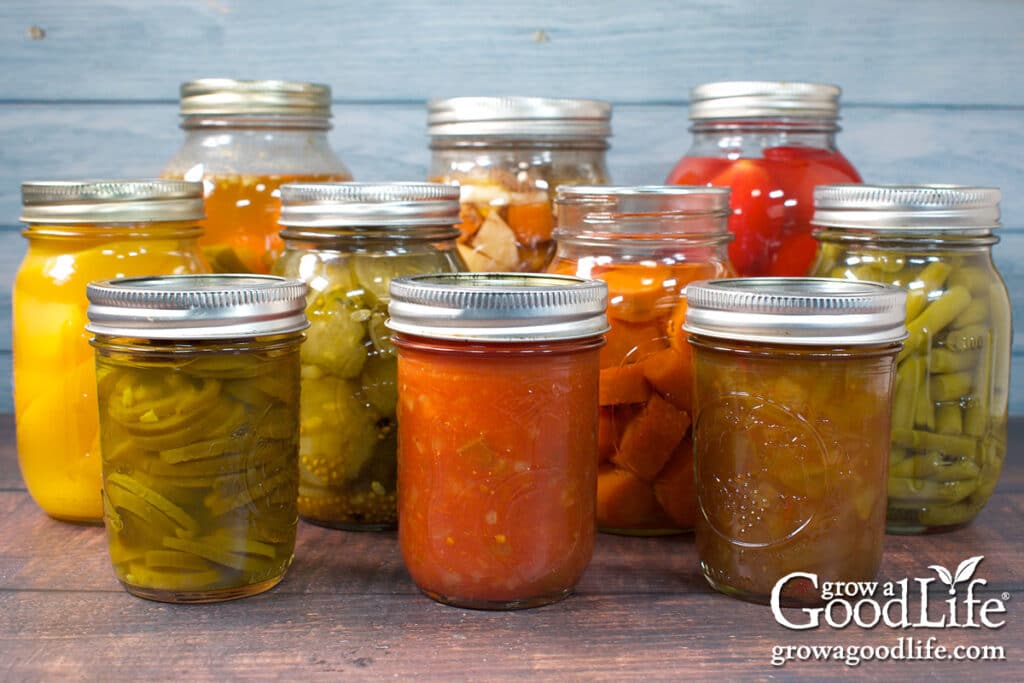
Safe Changes to Canning Recipes
If you’ve felt limited by the rigidity of canning recipes, you’re not alone. But the good news is that not all changes are off the table. Through careful research and testing, food preservation experts have identified a number of adjustments you can safely make to tested canning recipes without compromising food safety.
I’ve spent a lot of time digging into the most up to date publications from various university extension offices to gather this list of safe modifications you can make to canning recipes.
One of the best resources available is the Play it Safe! Safe Changes and Substitutions to Tested Canning Recipes guide from the North Central Food Safety Extension Network (NCFSEN). It provides clear, research-based guidance on which recipe modifications are considered safe. I highly recommend downloading a copy to keep alongside your canning books and printed recipes.
Before we go into the specific categories of food and the changes you can make, here are a few generally safe adjustments that apply to most tested recipes:
Generally Safe Adjustments
Start with a safe canning recipe such as those found on the National Center for Home Food Preservation, Ball Mason Jars, and Bernardan Home Canning websites, along with the canning books found here: Safe Canning Books to Add to Your Library.
While canning recipes are carefully developed to ensure safety, the following adjustments can be made without compromising that safety:
Use a Smaller Jar Size
You can safely use a smaller jar size than the recipe calls for, such as half-pints instead of pints, but you must process the jars for the full time listed for the original size. Never use a larger jar unless it is specifically included in the tested recipe since larger jars take longer to heat through.
Pressure canning note: If you use half-pint jars in a pressure canner, make sure they sit above the water line. You may need a taller rack in the bottom of the canner to prevent the jars from being submerged. Read more on this tip from NCHFP: Jars Should Not be Fully Submerged.
Reduce or Omit Salt
Salt is used mainly for flavor in most canning recipes (except brined pickles or fermented foods, where it plays a preservative role). It’s safe to reduce or completely leave out the salt. You can always season to taste when you open the jar later.
Swap Similar Ingredients
You can substitute ingredient varieties with others in equal amounts. These are safe swaps:
- Peppers: Swap one variety of pepper for the same amount of another, such as bell peppers for Anaheim. This is the best way to tweak salsa recipes.
- Tomatoes: Substitute one variety of tomato for an equal amount of another, such as substituting San Marzano for Roma tomatoes.
- Onions: You may use different bulb onion types interchangeably, such as yellow, white, or red.
- Lemon juice for lime juice: Bottled lemon and lime juice can be swapped if the recipe calls for either. Always use bottled, not fresh, to ensure consistent acidity.
- Vinegar: You may use different types of vinegar, such as white vinegar, apple cider vinegar, or red wine vinegar, as long as they are at least 5% acidity.
- Dried herbs and spices: Feel free to swap dried herbs or seasoning to your taste. For example, you can swap dried oregano for the same amount of dried basil. Stick to dried herbs unless the recipe calls for fresh because fresh herbs can change the pH and density of a recipe.
These general guidelines offer flexibility when it comes to flavors. Next, I will highlight specific categories of home-canned foods, such as tomatoes, salsas, pickles, vegetables, meats, fruits, soups, and meals, and go over the safe substitutions and tweaks you can make.
Safe Changes and Substitutions by Food Type
While there are some general adjustments you can safely make to most canning recipes, others depend on the specific type of food being preserved. Each type of food brings its own safety considerations when it comes to home canning. The texture, acidity, and density of fruits, vegetables, meats, and mixed recipes all play a role in how a recipe is safely processed.
That’s why I have created individual guides for tomatoes, salsas, pickles, vegetables, meats, fruit, and soups so you can confidently make informed choices based on the ingredients you’re working with.
In this series, we’ll look at additional safe changes you can make based on the type of food you are canning, using information gathered from research-based extension sources.
Below is a quick overview of what you can and can’t modify for each category, along with links to the full articles for more detailed information.
Tomatoes and Tomato Sauces
Tomatoes are one of the most popular foods to can at home, but they require special attention to ensure safety. Because tomatoes are on the borderline between high-acid and low-acid foods, safe canning depends on proper acidification and following tested processing methods. Even small changes can alter the pH, which can impact whether the product is safe for canning.
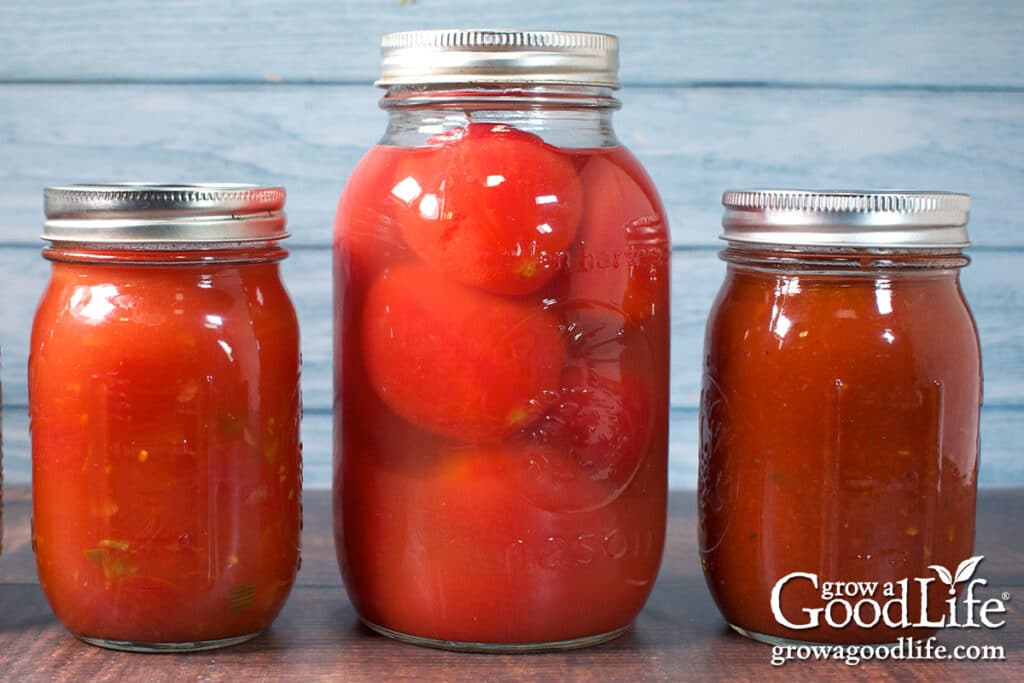
Safe substitutions you can make to tomato canning recipes:
Below are safe modifications you can make when canning tomatoes and tomato-based products using a safe canning recipe:
- Swap tomato varieties: You may safely substitute different varieties of tomatoes, such as paste, slicing, or heirloom types, in tested recipes, as long as the total amount stays the same.
- Adjust dried herbs: You may exchange one herb for an equal amount of another, or you can omit them altogether. If your recipe calls for dried herbs, stick with dried. Adding fresh herbs can alter the pH.
- Add sugar: You may add a small amount of sugar to balance acidity and improve flavor. A general guideline is: Up to 1 teaspoon of sugar per pint or 2 teaspoons per quart.
👉 There’s more to explore! Learn all the safe tweaks you can make in our full guide: How to Safely Modify Tomato Canning Recipes.
Salsa
Salsas are a popular way to preserve your garden harvest, but because they combine low-acid and high-acid ingredients, they require carefully tested recipes to ensure they are safe for home canning. The ratio of ingredients such as tomatoes, peppers, onions, and acid is critical to maintain the proper pH level and prevent the growth of harmful bacteria.
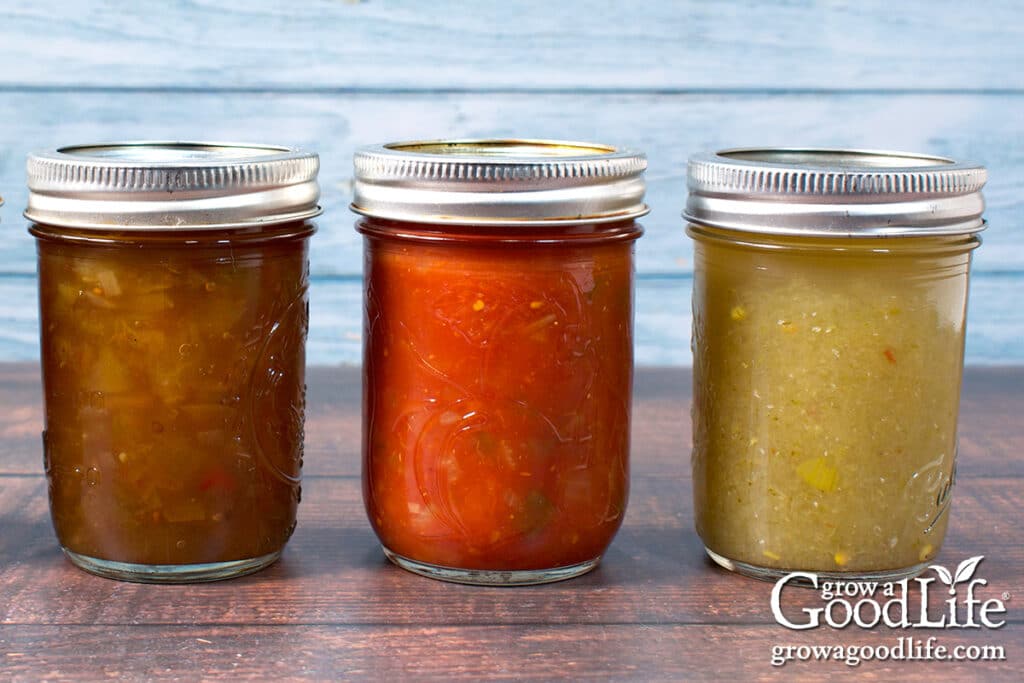
Safe substitutions you can make to salsa canning recipes:
If you’re following a tested salsa canning recipe from a reliable source, there are some minor ingredient adjustments you can safely make to customize the flavor of your salsas:
- Swap pepper types: You can substitute one kind of pepper for another, for example, using hot chiles instead of mild bell pepper, as long as you don’t increase the total amount of peppers listed in the tested recipe.
- Substitute the vinegar: If your recipe calls for vinegar, you can use any vinegar as long as it is 5% acidity, such as white or apple cider vinegar.
- Swap vinegar for bottled lemon or lime juice: You can safely swap some or all of the vinegar for bottled lime or lemon juice.
👉 Wondering how to safely customize salsa recipes for canning? Find all the approved tweaks in the guide: Safe Adjustments for Canned Salsa Recipes.
Pickles and Relishes
Pickled vegetables are a delicious way to preserve the harvest, and one of the most creative areas of home canning. From bread and butter cucumber pickles to dilly beans, there’s a lot of room to personalize flavor.
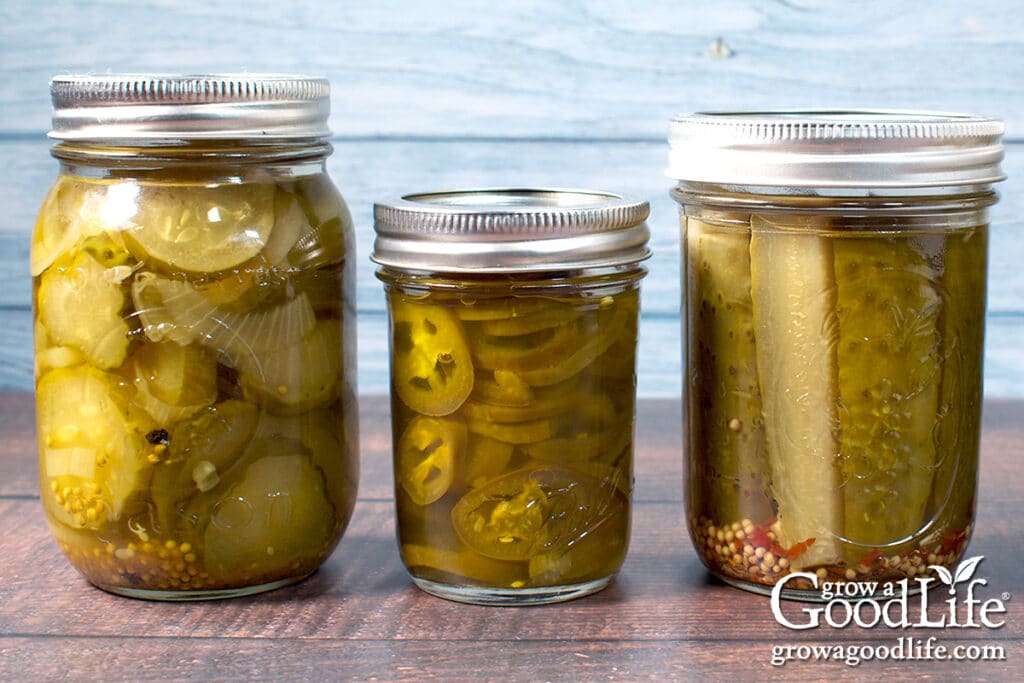
Here are some safe modifications you can make when canning pickled foods:
- Adjust the salt: One of the most common questions I receive on pickled recipes is, “Can I use less salt?” The answer is yes, but it will affect the flavor and texture of the pickled vegetables.
- Swap the vinegar: You can safely swap the type of vinegar, such as white vinegar, apple cider vinegar, or red wine vinegar, as long as the acidity level stays at 5%.
- Adjust dried spices: Add, reduce, or omit dried seasonings like mustard seed, dill seed, coriander, chili flakes, or bay leaves.
- Add a clove of garlic or a small dried pepper to each jar in any tested pickle recipe without impacting the processing time.
👉 Looking for more ways to tweak your pickle and relish recipes safely? Check out the full article: How to Modify Pickle and Relish Canning Recipes Safely.
Pressure Canned Vegetables
Vegetables are low-acid foods, which must be processed in a pressure canner to destroy harmful bacteria like Clostridium botulinum. Because of the safety concerns involved, there’s very little flexibility when it comes to altering pressure canning recipes. However, there are a few safe modifications you can make to adjust flavor of your home canned vegetables:
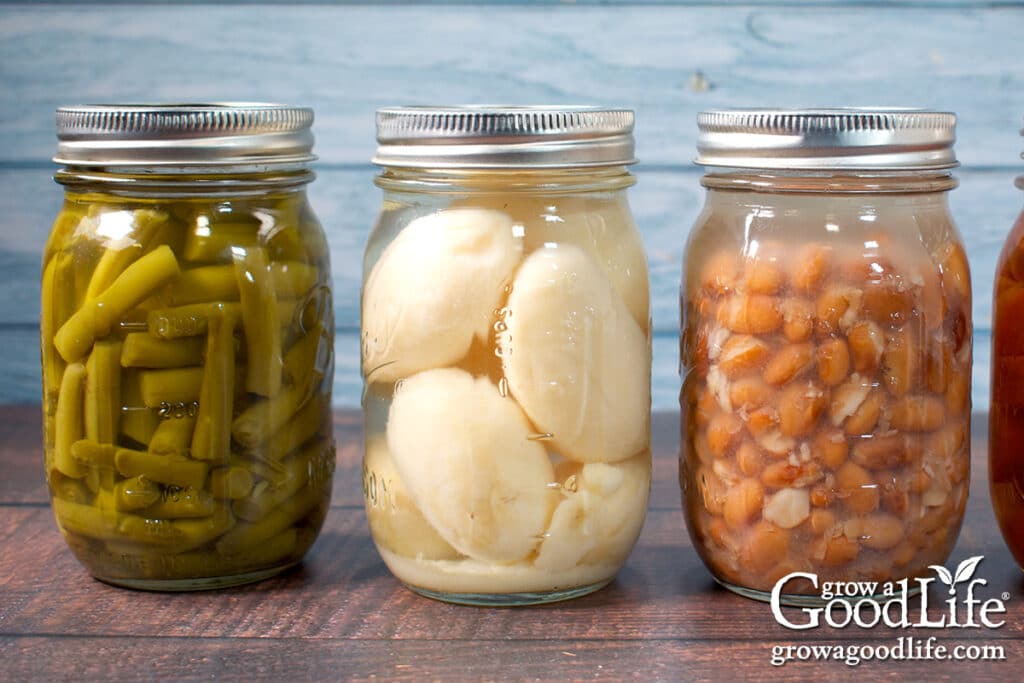
Safe substitutions you can make to pressure canned vegetables:
- Omit or reduce salt: Salt is not required for safety. It’s added purely for flavor. You can safely reduce or omit the salt when pressure canning vegetables. Seasoning can always be adjusted when serving.
- Add a garlic clove: You may safely add up to one garlic clove per jar. This adds flavor without impacting processing time.
- Include dried herbs or spices: You can safely add up to 1 teaspoon of dried herbs or spices per jar. Options include garlic powder, onion powder, thyme, oregano, or bay leaves.
👉 Are you curious about other safe changes you can make when pressure canning vegetables? Explore the guide Safe Tweaks for Pressure Canning Vegetables.
Pressure Canned Meat and Poultry
Meat and poultry are dense, low-acid foods that must be pressure canned using specific times and methods to ensure safety. Due to their structure and fat content, substitutions must be made carefully to ensure heat penetrates thoroughly during processing.
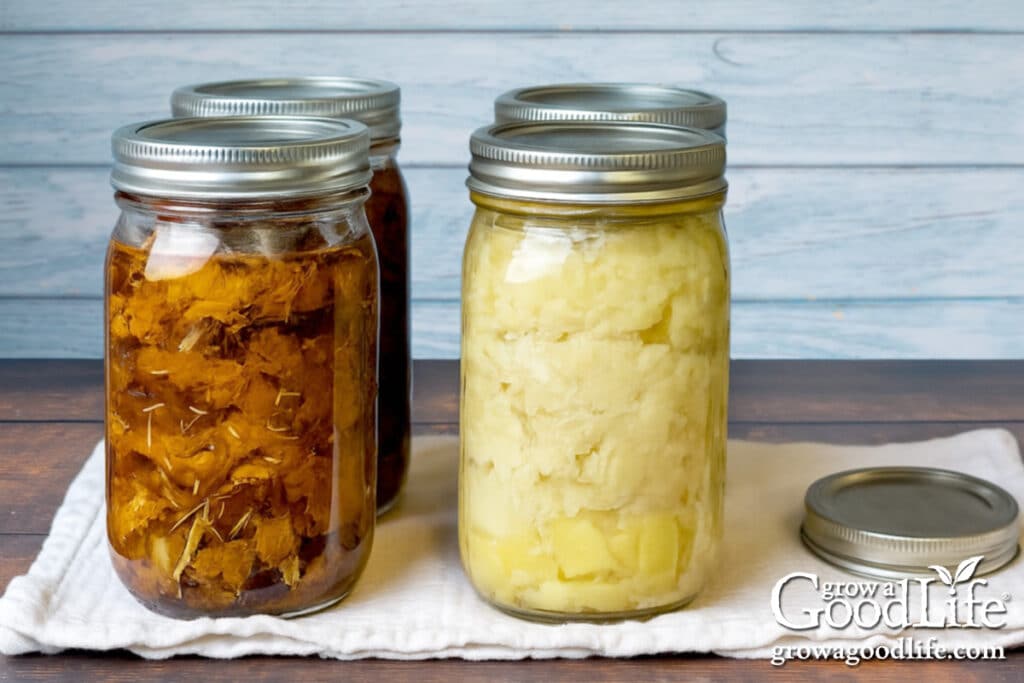
Safe substitutions you can make:
While safety must come first, there are a few approved adjustments you can make to customize flavor of home canned meat and poultry without affecting processing time:
- Swap cuts of meat: You can safely substitute one cut for another (chicken thighs for breasts, or round steak for chuck) as long as the weight or volume stays the same.
- Adjust seasoning: Salt, herbs, and spices can be adjusted, reduced, or omitted based on preference.
- Add fresh onions or garlic: You can include up to 1 tablespoon per pint or 2 tablespoons per quart of fresh chopped, sliced, or minced onions or garlic.
👉 Want more tips on what you can change? Read: Safe Changes for Pressure Canning Meat and Poultry.
Fruits, Juices, and Preserves
Most fruits are naturally high in acid, which makes them safe for water bath canning when processed correctly. However, modifying the amount of sweetener, liquid, or fruit in a recipe can change the texture and flavor. Jams, jellies, and sauces also require specific ratios of fruit, sugar, and pectin for proper gel and preservation.
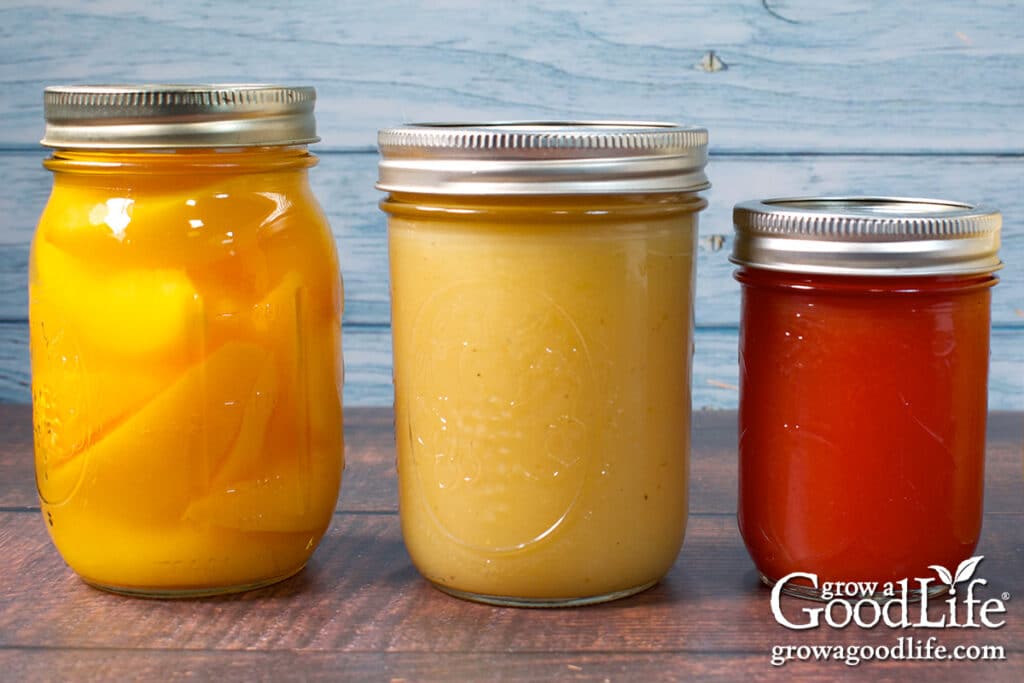
Here are some safe changes you can make when canning fruits:
- Change syrup strength: When canning whole or sliced fruit, you can use water, fruit juice, or lighter sugar syrups without affecting safety.
- Replace some sugar with honey: If you enjoy the flavor of honey, you can replace up to half the sugar in the recipe with honey. This can add a lovely floral sweetness and works well in fruit sauces and whole fruit canning recipes.
- Adjust spices and flavorings: It’s safe to add or omit flavorings like cinnamon, vanilla, or lemon zest in small amounts.
👉 Want to learn how to safely adjust sugar, swap fruits, or add flavor to home-canned fruit, juices, sauces, and preserves without compromising food safety? Read: Safe Tweaks for Canning Fruit, Juice, and Preserves.
Soups and Meals in a Jar
Soups, stews, chilis, and other meals in a jar are popular to can at home because they’re convenient and delicious, but they’re also among the most complex to preserve safely. These are low-acid foods that often contain a mix of meat, vegetables, beans, and broth, all of which require pressure canning and careful attention to ingredient proportions.
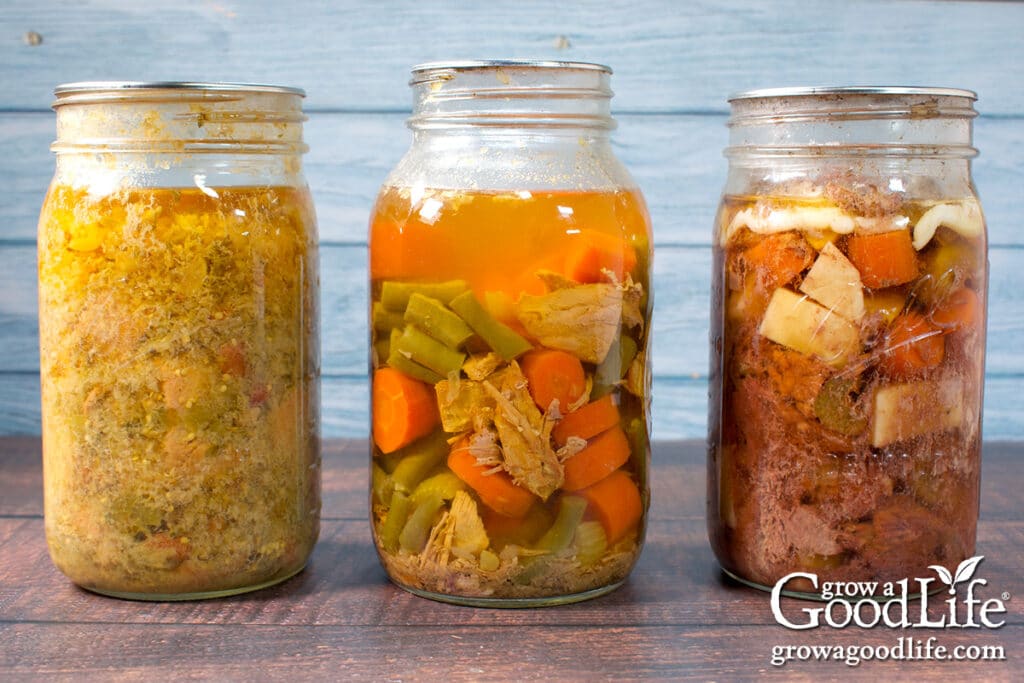
Safe changes you can make:
- Swap meats in equal amounts: You can exchange chicken for turkey, pork for beef, or round steak for chuck roast. Just keep the total volume the same.
- Reduce or omit vegetables: You can safely reduce or leave out any vegetables that you don’t like.
- Adjust seasoning: Dried herbs and spices can be easily adjusted or exchanged to suit your taste. For example, you can use thyme instead of oregano or add crushed red pepper for a bit of heat.
👉 Want to safely adjust home canned soups, stews, and meal jars? Learn what you change (and what’s not) in the full article: How to Safely Adjust Canning Recipes for Soups and Meals in a Jar.
Foods that are Unsafe to Can
Not everything can be home canned safely. While commercial food producers rely on high-end equipment and laboratory testing, home canners are limited to the research-based methods developed by the USDA, Ball, and university extension labs.
We also rely on canning equipment designed for home kitchens, which makes it critical to follow tested guidelines and avoid foods that haven’t been approved for safe processing.
These foods should not be home canned:
- Dairy Products: Milk, cream, butter, and cheese contain high levels of fat and protein that make it difficult for heat to penetrate evenly and kill harmful bacteria.
- Thickeners: Ingredients like flour, cornstarch, or arrowroot can prevent heat from circulating properly in the jar, increasing the risk of botulism. Thicken your food after opening.
- Grains and Pasta: Rice, barley, quinoa, and pasta absorb liquid and expand during processing, making it hard to ensure the jar contents heat evenly all the way through.
- Pumpkin or Winter Squash Purees: Only cubed pumpkin or squash has been tested for safe pressure canning. Purees are too dense and can trap heat unevenly.
- Cured or Processed Meats: Ham, bacon, sausage, and other processed meats contain preservatives, high fat content, or curing salts that interfere with safe heat penetration.
- Eggs: Whether raw, scrambled, or pickled, eggs have not been proven safe for home canning and should be stored using refrigeration or freezing methods.
- Custom Recipes: Homemade sauces, salsas, soups, or stews that haven’t been lab-tested may not have the proper acid balance or density for safe canning.
If a recipe or food item hasn’t been tested for home canning, it’s best to freeze it or refrigerate it for short-term storage. When it comes to food safety, it’s always better to be cautious.
Final Thoughts
Home canning is a rewarding way to preserve the harvest and enjoy your favorite foods year-round, but it also means taking extra care to ensure everything you preserve is safe to eat. While tested recipes are carefully developed to balance safety, quality, and flavor, that doesn’t mean you can’t make them your own.
This article is just the beginning of our series on safe canning substitutions, where we break down which changes are backed by research and which ones could compromise safety. From reducing sugar in fruit preserves to swapping peppers in salsa, knowing which adjustments are allowed gives you the freedom to customize your home canned goods with confidence.
The most important takeaway? Start with a tested recipe from a trusted source, make only the safe modifications outlined in this series, and always follow proper canning methods and processing times.
I hope this series empowers you to preserve creatively and safely. Be sure to explore the other articles for specific substitution guidelines by food type for even more tweaks you can make safely.
Resources and Further Reading:
- So Easy to Preserve. University of Georgia Cooperative Extension.
- Ball Blue Book Guide to Preserving. Ball Canning.
- Play it Safe! Safe Changes and Substitutions to Tested Canning Recipes. North Central Food Safety Extension Network (NCFSEN).
- Modifying Canning Recipes. South Dakota State University Extension.
- What Can You Change in a Canning Recipe? Penn State Extension.
- Interchangeable Meats in Canning #877114. AskExtension.
- Foods that are Not Safe to Can. Penn State Extension.
40+ Meals in a Jar Pressure Canning Recipes
In this eBook, you will find 50 pressure canning recipes, including 44 meals, along with homemade stocks and bone broths. Recipes include soups, stews, chilis, beans, beef, pork, and poultry. Explore the world of preserving delicious home-cooked meals for all seasons.

